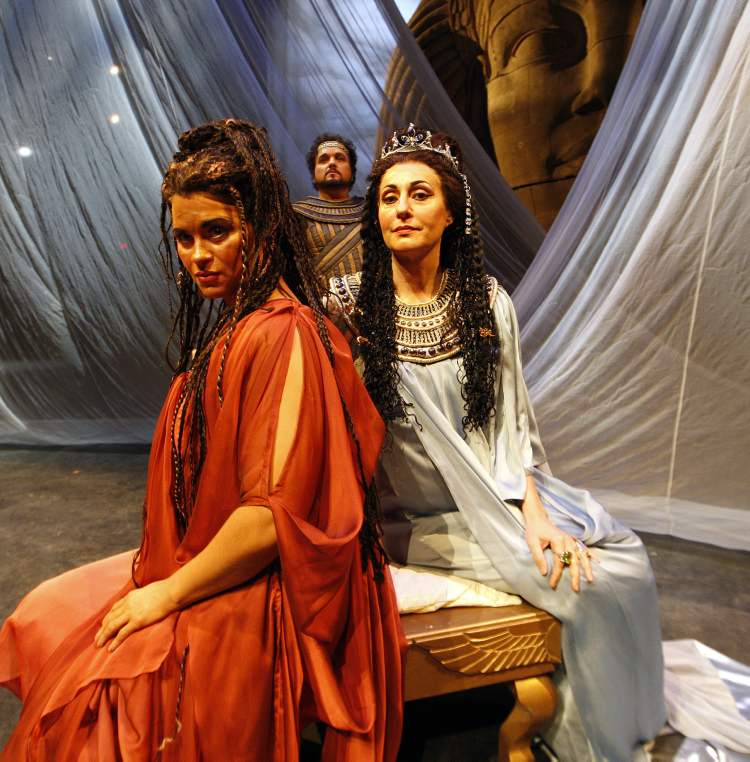Aida an awe-inspiring accomplishment
As an entertainment piece, this presentation has it all
Advertisement
Read this article for free:
or
Already have an account? Log in here »
To continue reading, please subscribe:
Monthly Digital Subscription
$19 $0 for the first 4 weeks*
- Enjoy unlimited reading on winnipegfreepress.com
- Read the E-Edition, our digital replica newspaper
- Access News Break, our award-winning app
- Play interactive puzzles
*No charge for 4 weeks then billed as $19 every four weeks (new subscribers and qualified returning subscribers only). Cancel anytime.
Read unlimited articles for free today:
or
Already have an account? Log in here »
Hey there, time traveller!
This article was published 14/04/2013 (4026 days ago), so information in it may no longer be current.
Poor Aida! She never seems to have anything go her way. From the opening scene of Manitoba Opera’s lavish production of Verdi’s beloved four-act opera Saturday night, we knew the ill-fated Ethiopian title princess (disguised as a slave) was conflicted.
Canadian soprano Michele Capalbo is the embodiment of the long-suffering Aida, in love with Radames, captain of the guard. In dramatic stance, she sang of her contradictory loves for her father, the Ethiopian king, her country and Radames. We could feel her heartbreak through the passion of her lithe singing in Ritorna vincitor, every note crafted to shimmering perfection. Capalbo’s ability to make the softest pianissimo note build and swell into a booming fortissimo is nothing short of extraordinary. (And she makes it seem easy.)
Aida’s love interest, Radames, played by Puerto Rican tenor Rafael Davila, returns her affection, proclaiming his love eloquently in Celeste Aida, forma divina, sustaining the ultimate B-flat with impressive assurance. Davila’s robust voice is versatile, enabling him to exude the confidence of the conquering hero, yet also portray the sweet lover to the hilt. Only a slight crack in his voice as he reached for the upper register in Pur ti riveggio, mia dolce Aida signalled some fatigue.

Here’s where things got complicated. Aida’s employer, Amneris (Italian mezzo-soprano Tiziana Carraro) daughter of the King of Egypt, also loves Radames. Amneris is determined to marry Radames, but suspects that Aida is her rival.
Carraro has a true presence onstage, with her sultry walk and strong features. Her velvety, somewhat throaty, vocal quality aptly conveyed her jealous doubts. One distracting tendency, however, limited her ability to engage the audience. As she sang, she cast her eyes downward, only looking up when she stopped singing. She never looked out beseechingly for empathy; rarely looked at her singing partners, even when declaring love to Radames. This denied any real chemistry between characters.
David Watson sang the role of the King of Egypt with his customary reliability and wonderful clear diction. Tenor Terence Mierau took his brief role of messenger to heart, giving it an impassioned performance and it’s always a pleasure to hear the fine, pure voice of Winnipeg soprano Lara Ciekiewicz, resplendent here as the High Priestess.
All eyes were drawn to bass Phillip Ens as Ramfis, High Priest of Egypt in his gold-encrusted robe. He brought the requisite grandeur and authority to the role, his bold delivery and rumbling voice almost shaking the ground.
We didn’t see baritone Gregory Dahl (Amonsaro, King of Ethiopia/Aida’s father) until late in the opera, but his warm, powerful voice and commanding presence were worth the wait.
Of special note was the superbly balanced ensemble work — every individual voice distinguishable.
Mounting this work boasting over 100 performers onstage was an awe-inspiring accomplishment for director Brian Deedrick and stage manager Robert Pel.
As an entertainment piece, this presentation has it all — ornate, gilded sets, Egyptian friezes and a gigantic sphinx-like head designed by Roberto Oswald, lavish costuming from Edmonton Opera, and lighting by Scott Henderson that subtly assisted us to predict the action as it shifted with the mood.
The women’s chorus in the boudoir scene sang with flowing youthfulness, while the men were all pomp and power. Athletic dancers, several from the Royal Winnipeg Ballet Aspirant Program leaped across the stage wielding knives and swords. And the Winnipeg Symphony Orchestra in the pit was in good hands with conductor Tyrone Paterson, with just a few discrepancies in tempo between singers and orchestra. Bravo to the brass section for its authentically triumphant, military majesty.
The show repeats on Tuesday and Friday.
gwenda.nemerofsky@shaw.ca
History
Updated on Monday, April 15, 2013 6:54 AM CDT: replaces photo, adds fact box


